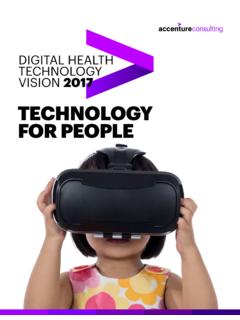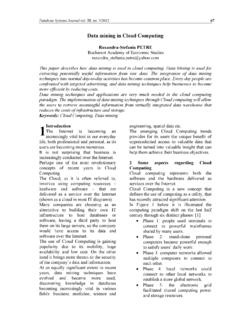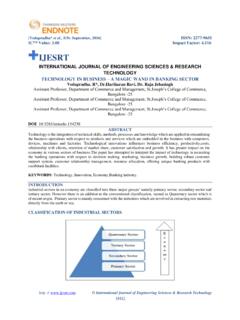Transcription of OECD Science, Technology and Innovation …
1 These highlights draw upon the OECD report (OECD, 2016) oecd science , Technology and Innovation outlook 2016 More information, thematic Policy and Country Profiles available at Ageing societies, climate change, health challenges and growing digitisation are, among other factors, expected to shape future R&D agendas and the scope and scale of future Innovation demand. Novel demands and markets are likely to emerge, creating new skills needs and new growth and job opportunities. New approaches to sustainable growth, through the circular economy, are also emerging.
2 STI is widely seen as key to addressing these grand challenges. STI activities could however be confronted with strong resource constraints. Possibly insufficient growth in developed and emerging economies, as well as competing policy priorities and agendas, may limit the financial resources available. Similarly, an ageing population, together with changing patterns in migration, might affect the availability of STI skills. This could compromise the role of STI to address future challenges. The megatrends raise urgent issues that demand urgent policy responses, including in the STI field.
3 But the capacities of governments to intervene will likely face major constraints, including high public debt, increasing international security threats, rising protectionist reactions, a possible erosion of social cohesion, and the rise of influential non-state actors that challenge their authority and ability to act. Future developments in STI could accelerate, intensify or reverse megatrend dynamics. But these developments also have the potential to offer solutions to the challenges we face. For example, Globalisation will be further enabled by advances in communications and transport technologies.
4 Global digital platforms are helping drive down costs of cross-border communications and transactions, thereby reducing the minimum scale at which businesses can operate globally and enabling small businesses to become micro-multinationals . Income growth will be increasingly driven by STI developments, especially in the digital economy. Between 2014 and 2020, an additional billion individuals will acquire a mobile phone for the first time. Both China and India will soon have more Internet users than the entire population of the and Western Europe combined.
5 In two or three years, Africa will connect more people than the has population. The sharing economy, enabled by smart apps, is expected to reach a global value of USD 335 billion by 2025. Reductions in CO2 emissions will depend on the development of new, cleaner energy Technology . Biotechnology offers unique solutions to dependence on oil and petrochemicals. Bio-based batteries, artificial photosynthesis and micro-organisms that produce biofuels are some recent breakthroughs that could support a bio-based revolution in energy production. And improved health outcomes and increasing life expectancy will heavily depend on health Technology Innovation .
6 While still small-scale and marginal, do-it-yourself science groups and maker communities are likely to be increasingly visible in the healthcare field, enabled by low-cost advanced technologies like synthetic biology and additive manufacturing that allow them to research and develop their own therapeutics and medical devices. On the other hand, emerging technologies carry several risks and uncertainties, and many raise important ethical issues, too. STI developments could exacerbate inequalities without wider Innovation diffusion and skills acquisition. Developments in artificial intelligence and robotics raise concerns around future jobs; the Internet of Things and big data analytics around privacy; 3D printing around piracy of intellectual property; synthetic biology around biosecurity; and neurosciences around human dignity.
7 Still, emerging technologies are expected to have wide impacts across several fields of application and will often depend on other enabling technologies for their development and exploitation. Technology convergence and combination could be further helped by cross-disciplinary working arrangements and skills training. Public sector science will continue to play leading roles in developing new knowledge and skills for nurturing these technological advances and supporting their exploitation in the wider economy. But it will also undergo its own transformation. Expenditures on R&D by universities and public research institutes (PRIs) in OECD countries, most of which is funded by governments, began flattening out in 2010 following three decades of growth (Figure 1).
8 Growth in public R&D budgets has slowed down in many countries as other policy priorities, such as state pensions, health and social care, have absorbed a growing share of public resources. Data on government budget appropriations and outlays for R&D (GBAORD) as a percentage of total government spending for 2000 and 2015 show that while countries like Germany, Korea, Portugal and Switzerland are spending more on R&D, others including Australia, France, Italy, Spain, the United Kingdom and the United States have reduced their R&D efforts. Furthermore, continued pressure on public finances in many countries and sluggish economic growth suggest that public spending on R&D (GBAORD), be it towards public research or business R&D, is likely to plateau at current levels or decline even further.
9 Figure 1. Expenditures on public R&D in OECD flatten out following three decades of growth OECD R&D expenditure, index 1981=100 Source: Based on OECD (2016), Main Science and Technology Indicators (MSTI) Database, June; Eurostat R&D Indicators and UNESCO Institute for Statistics, S&T Indicators, June 2016. Data extracted from on 22 July 2016, 1 2 Figure 2. R&D has fallen behind other policy priorities in many countries Government budget appropriations and outlays for R&D (GBAORD) as a % of total government expenditures, 2000 and 2015 on R&DDecreasedspending on R&D2015 20001 2 Source: OECD, Research and Development Statistics (RDS) Database, April 2016, ; OECD National Accounts Database, September 2016 ; Eurostat RD Databases August 2016, UNESCO Institute for Statistics, June 2016 and World Economic outlook Database, October 2016.
10 Data retrieved from on 26 November 2016. Part of the decline in GBAORD is also related to a more widespread use of tax incentives for R&D in recent years. This substitution between a spending approach (R&D budgets) and a non-spending approach (tax reliefs) signals a shift in the policy mix for Innovation towards firms and more economic objectives. Country responses to the latest EC/OECD International Survey on STI Policies (STIP) also confirm the recent policy focus given to restoring competitiveness and accelerating growth in many OECD countries and non-OECD key economies. Figure 3.
















